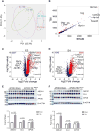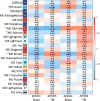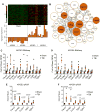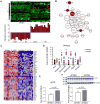Gene co-expression networks identify Trem2 and Tyrobp as major hubs in human APOE expressing mice following traumatic brain injury
- PMID: 28502803
- PMCID: PMC5530876
- DOI: 10.1016/j.nbd.2017.05.006
Gene co-expression networks identify Trem2 and Tyrobp as major hubs in human APOE expressing mice following traumatic brain injury
Abstract
Traumatic brain injury (TBI) is strongly linked to an increased risk of developing dementia, including chronic traumatic encephalopathy and possibly Alzheimer's disease (AD). APOEε4 allele of human Apolipoprotein E (APOE) gene is the major genetic risk factor for late onset AD and has been associated with chronic traumatic encephalopathy and unfavorable outcome following TBI. To determine if there is an APOE isoform-specific response to TBI we performed controlled cortical impact on 3-month-old mice expressing human APOE3 or APOE4 isoforms. Following injury, we used several behavior paradigms to test for anxiety and learning and found that APOE3 and APOE4 targeted replacement mice demonstrate cognitive impairments following moderate TBI. Transcriptional profiling 14days following injury revealed a significant effect of TBI, which was similar in both genotypes. Significantly upregulated by injury in both genotypes were mRNA expression and protein level of ABCA1 transporter and APOJ, but not APOE. To identify gene-networks correlated to injury and APOE isoform, we performed Weighted Gene Co-expression Network Analysis. We determined that the network mostly correlated to TBI in animals expressing both isoforms is immune response with major hub genes including Trem2, Tyrobp, Clec7a and Cd68. We also found a significant increase of TREM2, IBA-1 and GFAP protein levels in the brains of injured mice. We identified a network representing myelination that correlated significantly with APOE isoform in both injury groups. This network was significantly enriched in oligodendrocyte signature genes, such as Mbp and Plp1. Our results demonstrate unique and distinct gene networks at this acute time point for injury and APOE isoform, as well as a network driven by APOE isoform across TBI groups.
Keywords: Apolipoprotein E; Fyn; Immune response; Innate immune response; Myelination; Traumatic brain injury; Trem2; Tyrobp.
Copyright © 2017 Elsevier Inc. All rights reserved.
Conflict of interest statement
Conflict of Interest: The authors declare that they have no conflict of interest.
Figures








Similar articles
-
ABCA1 haplodeficiency affects the brain transcriptome following traumatic brain injury in mice expressing human APOE isoforms.Acta Neuropathol Commun. 2018 Jul 26;6(1):69. doi: 10.1186/s40478-018-0569-2. Acta Neuropathol Commun. 2018. PMID: 30049279 Free PMC article.
-
RNA-sequencing reveals transcriptional up-regulation of Trem2 in response to bexarotene treatment.Neurobiol Dis. 2015 Oct;82:132-140. doi: 10.1016/j.nbd.2015.05.019. Epub 2015 Jun 10. Neurobiol Dis. 2015. PMID: 26071899 Free PMC article.
-
Different mechanisms of apolipoprotein E isoform-dependent modulation of prostaglandin E2 production and triggering receptor expressed on myeloid cells 2 (TREM2) expression after innate immune activation of microglia.FASEB J. 2015 May;29(5):1754-62. doi: 10.1096/fj.14-262683. Epub 2015 Jan 15. FASEB J. 2015. PMID: 25593125 Free PMC article.
-
The Role of APOE and TREM2 in Alzheimer's Disease-Current Understanding and Perspectives.Int J Mol Sci. 2018 Dec 26;20(1):81. doi: 10.3390/ijms20010081. Int J Mol Sci. 2018. PMID: 30587772 Free PMC article. Review.
-
Cellular players that shape evolving pathology and neurodegeneration following traumatic brain injury.Brain Behav Immun. 2018 Jul;71:9-17. doi: 10.1016/j.bbi.2018.03.033. Epub 2018 Mar 27. Brain Behav Immun. 2018. PMID: 29601944 Review.
Cited by
-
Loss of Trem2 in microglia leads to widespread disruption of cell coexpression networks in mouse brain.Neurobiol Aging. 2018 Sep;69:151-166. doi: 10.1016/j.neurobiolaging.2018.04.019. Epub 2018 May 17. Neurobiol Aging. 2018. PMID: 29906661 Free PMC article.
-
ApoE4-associated phospholipid dysregulation contributes to development of Tau hyper-phosphorylation after traumatic brain injury.Sci Rep. 2017 Sep 12;7(1):11372. doi: 10.1038/s41598-017-11654-7. Sci Rep. 2017. PMID: 28900205 Free PMC article.
-
Myeloid-derived β-hexosaminidase is essential for neuronal health and lysosome function: implications for Sandhoff disease.bioRxiv [Preprint]. 2024 Oct 22:2024.10.21.619538. doi: 10.1101/2024.10.21.619538. bioRxiv. 2024. PMID: 39484433 Free PMC article. Preprint.
-
Microglia and Neuroinflammation: Crucial Pathological Mechanisms in Traumatic Brain Injury-Induced Neurodegeneration.Front Aging Neurosci. 2022 Mar 25;14:825086. doi: 10.3389/fnagi.2022.825086. eCollection 2022. Front Aging Neurosci. 2022. PMID: 35401152 Free PMC article. Review.
-
Immune Regulation of Adult Neurogenic Niches in Health and Disease.Front Cell Neurosci. 2021 Jan 20;14:571071. doi: 10.3389/fncel.2020.571071. eCollection 2020. Front Cell Neurosci. 2021. PMID: 33551746 Free PMC article. Review.
References
-
- Abraham CR. Reactive astrocytes and alpha1-antichymotrypsin in Alzheimer’s disease. Neurobiol Aging. 2001;22:931–936. - PubMed
-
- Acosta SA, Tajiri N, Shinozuka K, Ishikawa H, Grimmig B, Diamond DM, Diamond D, Sanberg PR, Bickford PC, Kaneko Y, Borlongan CV. Long-term upregulation of inflammation and suppression of cell proliferation in the brain of adult rats exposed to traumatic brain injury using the controlled cortical impact model. PloS one. 2013;8:e53376–e53376. - PMC - PubMed
-
- Alderson NL, Maldonado EN, Kern MJ, Bhat NR, Hama H. FA2H-dependent fatty acid 2-hydroxylation in postnatal mouse brain. J Lipid Res. 2006;47:2772–2780. - PubMed
-
- Alexander S, Kerr ME, Kim Y, Kamboh MI. Apolipoprotein E4 allele presence and functional outcome after severe traumatic brain injury. Journal of Neurotrauma. 2007;24:790–797. - PubMed
MeSH terms
Substances
Grants and funding
LinkOut - more resources
Full Text Sources
Other Literature Sources
Medical
Molecular Biology Databases
Miscellaneous

